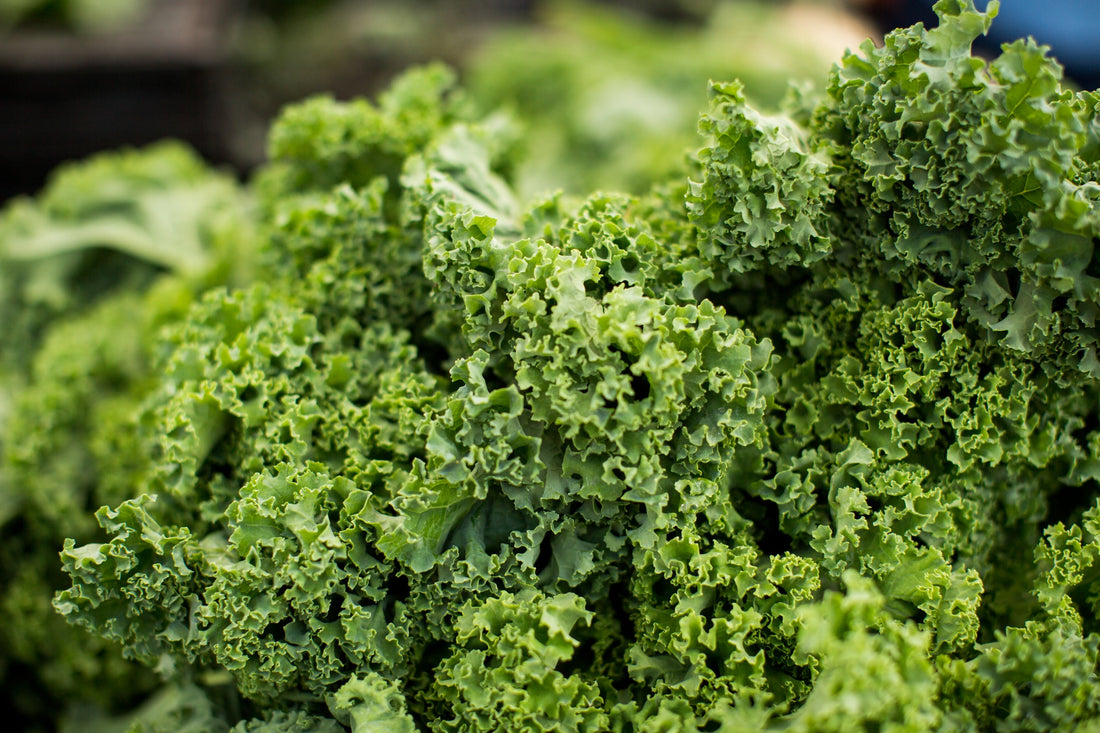Kale has been around for a very long time, but has gained huge popularity in recent years as a superfood. This cabbage relative is extremely easy to grow, versatile, and very nutritious. It’s leaves can be eaten fresh, steamed, stir-fried, sautéed, or added to soups and green smoothies.
SOIL PREPARATION
Kale prefers a sandy soil that is rich in organic matter, well drained, and not too heavy. It also needs full sun exposure. Before planting, incorporate 2-3 inches of well composted organic matter and 1-2 lbs of all-purpose fertilizer (we recommend “That’s All it Takes” complete fertilizer) per 100 square feet and work them into the soil to a depth of 4-6 inches. Heavy, clay-based soils must be amended with compost and organic matter to encourage and allow good root development. If you have heavy soil, we recommend 4-6 inches of organic matter and 50 lbs of Utelite or Zeolite per 200 square feet added to the soil each fall for multiple years to increase drainage and nutrient availability. Over time, you can create a better growing environment for your garden plants to thrive in and produce. Please see our information sheet “Preparing your Soil” for more detailed info on soil preparation before planting a garden.
PLANTING
Kale is almost always grown from seed and can be sown directly outside anytime after the soils reach 40 degrees. Plants perform best at temperatures below 75 degrees, and young plants can survive unharmed in as cold as 25 degree weather, so plant it as early as you can. The best time to plant in Cache Valley is in March and April, and again in August and September for a fall crop; a late-season frost actually improves the flavor. Plant seeds about 1/4-1/2 inch deep and cover with a light mulch or potting to prevent soil crusting and to help retain moisture. Try to maintain uniform soil moisture for 7-10 days or until the seeds begin to emerge. As the seedlings begin to grow, thin the plants out to 1-2 inches apart in the rows, and 12-18 inches between rows.
VARIETIES
Dwarf Blue Curled, Red Russian, and Black Magic or “Dinosaur” are all very hardy, heavy producers. Each has it’s own unique look and texture. Champion and other collards varieties are frequently listed as kale, and they produce a smooth, rounded leaf, but do not form heads.
WATER
Kale needs regular water and consistent soil moisture to produce well. Use of a soaker hose and light mulches can assist in maintaining correct soil moisture and guaranteeing a healthy harvest. We recommend about 1-2 inches of water applied per week in 2-3 applications. Watering stresses can lead to tough leaves and bitter flavor.
FERTILIZER
About 4-5 weeks after germination, apply a balanced vegetable food (“That’s All it Takes” or Happy Frog Organic Tomato & Vegetable Food) down the side of the row of plants and water thoroughly. 1-2 cups per 10 feet of row works well. For more leafy greens, use a higher nitrogen fertilizer like 21-0-0. We recommend the Tomato & Vegetable Food because it contains many micro-nutrients (like Boron & Iron) that prevent common problems in developing vegetables. We also recommend treating your kale seed or plants with beneficial microbes and mycorrhizae (Kangaroots or Myke). These added helpers bring nutrients and water directly to the plants that host them, making them stronger, more resistant to insects and diseases, and more drought tolerant.
COMMON PROBLEMS
Since kale is in the same family as cabbage and broccoli, they share many of the same problems. Keep the weeds to a minimum with the use of pre-emergents and organic mulches. Treflan and Corn Gluten weed preventative herbicides are very effective ways to stop weeds before they start, saving you hours and hours of weeding. Be sure to control weeds when they are small to ensure damage is not done to tender, young root systems when weeds are removed. Practice crop rotations to discourage pest problems. Kale is subject to aphids, cabbage loopers, imported cabbage worms, and cabbage root maggots. Row covers will help protect plants from all of these pests. Caterpillars may also be controlled using Bacillus thuringiensis (B.T.), spinosad, or pyrethrin. We prefer Spinosad (since it is bacterial, it has no effect on people or pets), which is most effective when sprayed early or late in the day. Aphids can be controlled with an insecticide like Ferti-lome Broad Spectrum Insecticide or Ferti-lome organic Triple Action.
HARVESTING
About 8 weeks after sowing, cut off outer stalks near the base, allowing the center stalks to continue growing. Cut the leaves off about 1 inch above the ground. Yields about 8-12 lbs per 10-foot row. If you decide to harvest the entire plant, leave the root system, fertilize with a water-soluble fertilizer (Grow Big or Baicor All Purpose) and in a few weeks it will come back, but not as effectively as Swiss Chard. Kale is more heat tolerant than say, broccoli or cabbage, but with heat and water fluctuations, it can also bolt and go to seed. Kale can be stored 1-2 weeks when refrigerated.

